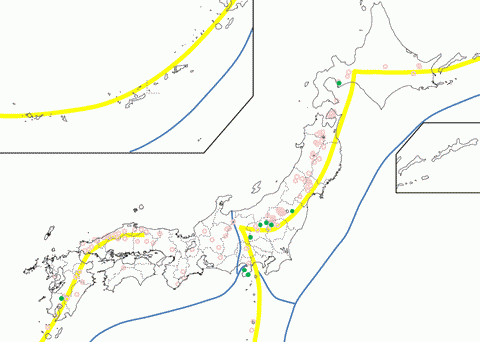Hydrothermal Au-Ag Deposit
Chemical Process (Liquid-phase Growth) - Open system under ground
Synonym
Telethermal Deposit, Low-T Hydrothermal Vein Deposit, Low-T Hydrothermal Ore Deposit
Index Minerals
Electrum, Silver
Required Geological Setting
Associated metasomatic zones
Halloysite zone, Cristobalite zone, Smectite zone, Stilbite-Mordenite zone
Occurrence
Vein-type deposit formed by 50-100 degree hydrothermal fluid originated from Acidic (Rhyolite), Neutral (Dacite, Andesite), or Alkaline (Basalt) magmatic activities by volcanoes such as caldera complexes in volcanic island arc. Origin of hydrothermal fluid is meteoric water and/or seawater, which are circulated by heat of magma. This type of deposits is formed at shallow circumstances whereas Hydrothermal Au-Bi-Te deposits are formed at deep circumstances by the same 50-100 degree hydrothermal fluid. Typical elements concentrated are Au, Ag, and/or Te. Host of deposits are volcanic products or basements of volcanoes. Mineral assemblages depends on geological settings of deposits; terrestrial volcano, sumarine volcano, and host rock types in which hydrothermal fluid circulated. The deposit may shift to Moderately low-T hydrothermal deposit or Moderate-T hydrothermal deposit in the deeper level, and to Hot spring deposit in the shallower level.

Distribution of Low-T Hydrothermal Au-Ag Deposits described in this site. Yellow lines are volcanic fronts.
Mineral Assemblages (Ore)
Gold, Electrum, Silver, Acanthite, Pyrite
Mineral Assemblages (Gangue)
Quartz (Acidic-Neutral), Mordenite (Alkaline), Adularia, Calcite, Truscottite
Localities
- Shobusawa (Izu Peninsula)
- Seikoshi Mine (Izu Peninsula)
- Toi Mine (Izu Peninsula)
- Tensho Mine (Izu Peninsula)
- Takatama Mine (Gold/Silver deposit)
- Nishizawa Mine (silver sulfides)
- Nebasawa Mine (Gold/Silver deposit)
- Hishikari Mine (Kyusyu Island)